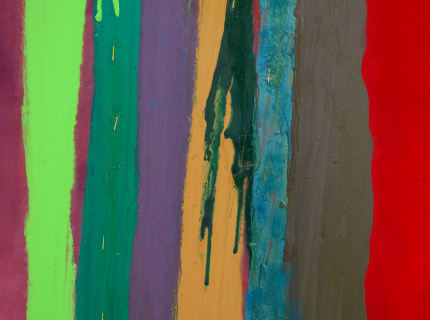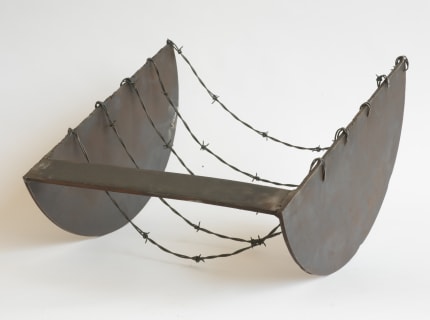In 1969 Stony Brook University was in dire straits. Having been rocked by anti-war protests, student demands for a Black studies program, and a drug raid on campus, the institution was under pressure to radically transform just over a decade after its founding. Amid these circumstances, the school invited British Guyanese artist Frank Bowling to curate an exhibition of works by Black artists, sponsored by a new “Afro-American Studies Program.” Bowling seized on the opportunity, later declaring that “young people clamoring for more and better Black studies” were its “natural audience.”
Bowling invited five African American artists—Melvin Edwards, Daniel LaRue Johnson, Al Loving, Jack Whitten, and William T. Williams—to join him in exhibiting work. The show’s title, “5+1,” gently set him apart as both the curator and the only non-American participant. Despite their disagreements about representational politics and their varying relationships with predominantly white gatekeeping institutions, the artists lamented the reigning expectation that Black artists should produce overtly political, figurative work. At the time, abstraction was often presumed to be the preserve of white artists with silver-spoon upbringings; prominent advocates like Clement Greenberg systematically overlooked Black artists. Bowling and his artists showcased their work at a time when major institutions were just beginning to work with Black artists, and they neither spoke directly to political questions of the day in the recognizable style of the Black Arts Movement (BAM) nor acted indifferent to the struggle to improve conditions for Black art. The exhibition demonstrated more indeterminate forms of expression to the same young students who were attending Black Students Union meetings, writing fiery op-eds, and participating in sit-ins.
Little survives from “5+1,” aside from the pamphlet and photographs of the lively opening by photographer and painter Adger Cowans. “Revisiting 5+1,” staged this winter at the Paul W. Zuccaire campus gallery at Stony Brook, is the result of assiduous research by PhD candidates into the original exhibition, despite the archival gaps. A number of the original works have since been lost or destroyed, so the current show exhibits works by the same artists made around the late ’60s. It also incorporates work by women; Howardena Pindell curated a section that presents Black female artists active in the 1960s and ’70s who also created work largely out of step with BAM and struggled to receive recognition from major institutions.
Prominently featured in both the 1969 exhibition and “Revisiting 5+1” are similar barbed wire curtains by Edwards, hemmed at the bottom by lengths of rusted metal chain. Although their materials have associations with confinement and oppression, both works transform the severe wire and metal into a gossamer-like and playful architecture. In Cowans’s pictures, out-of-focus strands of wire often float harmlessly in the foreground of animated conversations between artists and friends, adding texture and a sense of leisure to the shots.
Other standout works include a large 1968 painting by Whitten that commands the exhibition with its infernal blood-orange hue. Layered with indeterminate forms, faint gestures evoking spray paint, and broad strokes and dripping splatters of oil, the canvas is energetic and chaotic, reflecting its turbulent times. Near Whitten’s canvas is an untitled Johnson painting (ca. 1969) on a tall wood panel showing an elongated, pyramidal shape composed of candy-colored vertical bands truncated before they reach their pinnacle. The central band is an intense yellow beam. The painting’s propulsive directionality, brought to an end ahead of its acme, might evoke thwarted intelligence and purpose. Alternatively, it encourages viewers to complete the mission on their own.
In his essay for the 1969 exhibition, Bowling wrote, “The structure of Black life has revealed, over centuries, a creative, self-perpetuating process of anarchist, pro-life zeal which a study of the fine arts and history alone, though helpful, can never fully define.” Viewers might crave historical or sociopolitical referents for the diverse abstract gestures on display—could the breaks of light in O’Neal’s paintings represent the difficulty of individual expression amid prevailing demands on Black artists, or could Eyeball read as the repurposing of a surveilling gaze cast on Black women? In the end, these explanations prove to be contortions for justifying work that requires no such justification.
...



